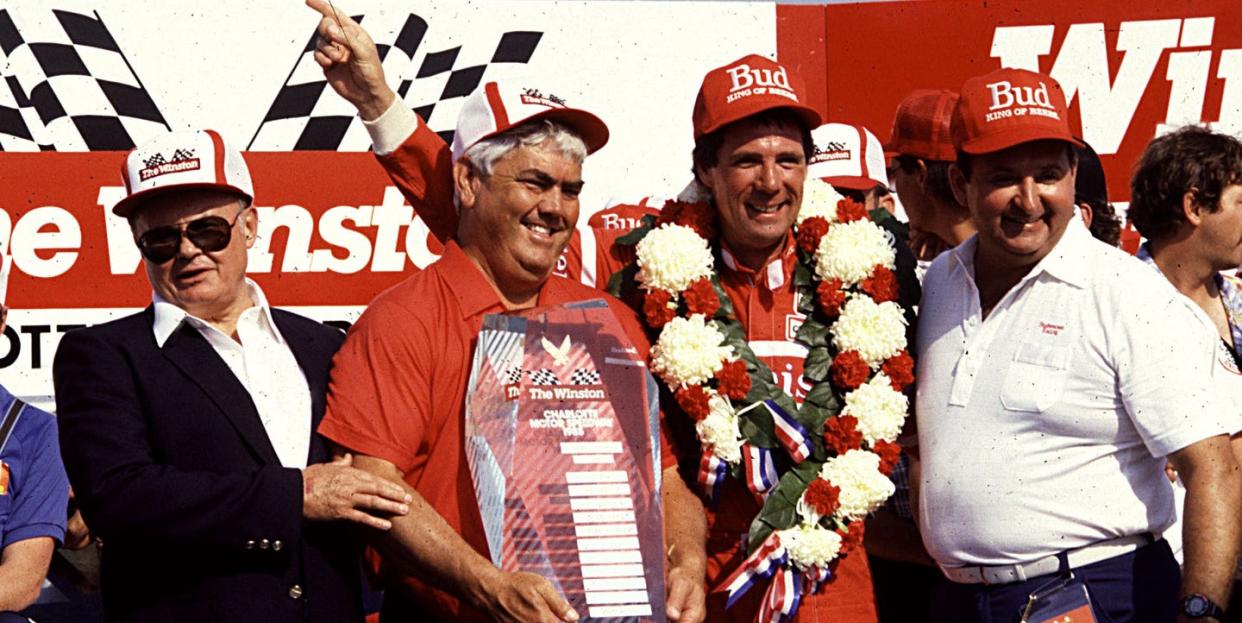NASCAR All-Star Race: What's the Point and Does It Still Matter

- Oops!Something went wrong.Please try again later.
- Oops!Something went wrong.Please try again later.
- Oops!Something went wrong.Please try again later.
For much of its 37-year history, NASCAR’s annual All-Star Race was considered one of the jewels of the season.
The first race, in 1985, featured a surprise finish as Darrell Waltrip took the checkered flag first, seconds before the engine in his Junior Johnson Chevrolet exploded. Rivals suspected Johnson, ever the “innovator,” had put a powerful but illegal engine in the car and that Waltrip destroyed it after the win to avoid the probing eyes of inspectors.
That set the course for what was then known as The Winston. Big money was at stake—the winner eventually got $1 million, and the fact that no seasonal points were involved gave the race an edgy Wild West flavor.
Over the years there were dramatic finishes: Davey Allison winning the first night race in 1992 after he and Kyle Petty crashed at the finish line. Rusty Wallace punting Waltrip on the final lap to win in 1989. Dale Earnhardt outdueling Bill Elliott in 1987 in a race that included Earnhardt surviving a ride on the infield grass.
The race became a hot ticket, thanks in large part to an evolving format that attempted to force dynamic finishes. Sometimes that concept worked; sometimes it failed miserably.
The race, originally intended to be spread around the Cup circuit, instead became a mainstay at Charlotte Motor Speedway, whose promotional experts poured coal into the All-Star engine to keep interest high. The COVID pandemic opened the door to moving the race to Bristol Motor Speedway in 2020, and last year’s event was held at Texas Motor Speedway.
The race returns to Texas Motor Speedway Sunday night, bringing with it a slice of uncertainty about its future and its relevance in a series that, after years of stagnancy, is looking toward new and different horizons. Instead of a special event, the race has carried a certain element of “just another weekend.”
Denny Hamlin has been among drivers suggesting that the race needs revitalization, possibly including moving it to a new venue each year. This week, Hamlin retweeted a Twitter comment that suggested that “NASCAR drivers and teams would rather have a couple weeks’ vacation than keep up the pretense of the All-Star Race.”
Chase Elliott endorsed the idea of rotating the race “to give fans in the different regions a special event. … It’s more like what other forms of sports do. I’m hoping that next year they switch it up and head somewhere else after being back in Texas for the second year.”
The winner’s purse is $1 million, which sounds like a lot for a short (125-lap) race, but the event has included that million-dollar victory payout for years, and it has lost some of its shine in the big picture. After all, a $1 million payday in 2000 is worth only about $592,000 in today's dollars, according to the U.S. Bureau of Labor Statistics calculations.
Big weekend ahead in Texas for @NASCAR's All-Star Race! This Sunday, don't miss Grand Marshal Blake talking with @ClintBowyer before the race on @FS1! -Team BS pic.twitter.com/pK4H5CuT91
— Blake Shelton (@blakeshelton) May 20, 2022
Early on, the race dropped some of its sparkle as it evolved from an invitational event for race winners (that is, “all-stars”) from the previous season (there were only 12 drivers in the inaugural race) to a sort of all-comers competition in which the entry requirements were liberalized. It now is difficult for the sport’s top drivers to not qualify for the race, a nod perhaps to officials fearing that a big name or two failing to qualify for the race might dampen ticket sales and television ratings.
The race format has been through a dizzying carousel of changes over the years, and this weekend’s is so bizarre that a slide rule might be needed to figure it out. Some drivers candidly have admitted they have no solid idea about the format. “We’ll show up and race” has been the general attitude.
After an unusual qualifying format that will feature two cars racing against each other for one lap after a four-tire pit stop, the race will be made up of four stages. The winner of the first stage will start on the pole for the feature as long as he finishes 15th or better in stages two and three, a rule designed to prevent the first-stage winner from lagging behind in the following stages.
After stage two, each team will do a four-tire pit stop. The team with the shortest time on pit road will earn its driver the fourth starting sport in the feature as long as he finishes 15th or better in stage three.
Your slide rule broken yet?
In the final 50-lap stage, NASCAR will throw a “competition” caution flag if no “natural” caution occurs between laps 15 and 25, thus keeping the field reasonably tight.
The race field will have 24 drivers. Twenty already have qualified, and four will be added after the All-Star Open “last chance” race.
The winner will be celebrated deep into the Texas night, and talk will continue about where the all-stars land next.

